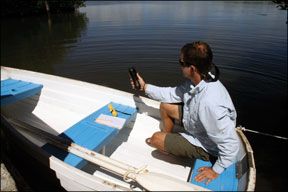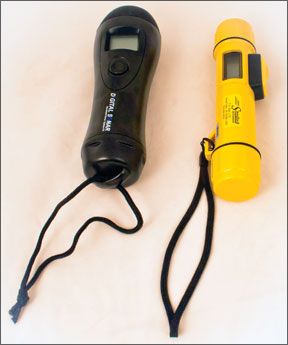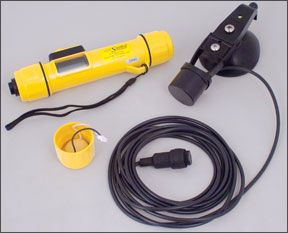One would expect that one of the least complicated and most critical pieces of electronic equipment on a boat would also be the most reliable. Sadly, this is not the case. One of the recurring gripes among PSreaders regarding electronics is the failure of their depth sounders. This is often due to a bad transducer, the underwater-mounted sending and receiving unit. Although transducers are typically covered under warranty, replacing one can require a haulout (which warranties wont cover), adding expense and aggravation.

Many cruisers opt for redundancy by installing a second transducer, or a second complete system. Of course, the simplest backup option-one that PS recommends regardless of how many depth sounders you have on board-is a good old leadline. A chunk of lead and a well-marked 3/8-inch line remains an invaluable tool on a modern cruising boat. Not only does this tool offer a backup in case of the sounder failure, it also allows you to probe creeks and narrow passes with your dinghy. When exploring shallow waters in your dinghy, a marked boathook or dinghy paddle also serves well.
The class of products reviewed this month take the leadline to the next level. Resembling small flashlights, these handheld sounders are designed to be portable, easy to use, and reliable. Yes, they require batteries, but because they use a momentary switch, they are only on for 10 seconds at a time, giving them an exceptionally long working life on one set of batteries. During field tests, users were able to use these units for months without having to change or charge the batteries.
What We Tested
This series of tests took a closer look at the Hawkeye 22PX from Norcross Marine and the Depthmate SM-5A. These were different units but the same models as those used by Beth Leonard and Evans Starzinger in 2008 while cruising aboard their boat, Hawk. The results of their long-term test with these sounders appeared in the May 2008 issue of Practical Sailor. Although other portable, battery-operated depth sounders can be found on the market, they are not what we would consider handheld units. (Humminbird, www.humminbird.com, makes several models of battery-operated fishfinders.)
The Hawkeye 22PX is made and distributed by Norcross Marine, a small marine company that caters primarily to recreational fishermen. Its budget-priced, standalone sounders did very well in our last comparison of digital depth finders in September 2003. Although the companys primary focus is digital electronic products such as depth sounders, fishfinders, and digital fish scales, it also makes a line of soft-sided coolers. One of its latest products is a dispenser for small microfiber cloths that can be used to clean sunglasses and multifunction LCD displays.
The SM-5A Depthmate is now among the short list of products imported by Laylin Associates, formerly known as Speedtech. (Meanwhile, Speedtechs line of wind instruments, which PS reviewed in May 2007, are now being sold by WeatherHawk, a division of Campbell Scientific.) According to the Laylin website, the company has been importing this “unique, Japanese-made portable sonar depth sounder for more than 10 years.”
How We Tested
Both units were tested on the water over the course of three days in the Gulf of Mexico and Little Sarasota Bay near Practical Sailors home office in Sarasota, Fla. This limited our test to depths of less than 50 feet, not a serious restriction since these units will be used primarily in near shore waters. PS plans to test them in deeper water in the future.
On-the-water testing comprised a series of six different tests in specific locations. Each unit was tested in the following conditions: murky (visibility less than 5 feet) shallow waters with a soft mud bottom; moderately clear waters (visibility of about 10 feet) of 10-20 feet with grass bottom; clear waters (visibility at least 30 feet) of 30-40 feet with sand bottom. For each test, readings were recorded in 10 different locations and averaged for rating.
Both makers claim that boaters can use their units to “shoot through” a variety of hull materials to obtain depth readings. The shoot-through capability of each unit was tested in moderately clear waters of 10-20 feet. For this test, each sounder was used first directly in the water, then as directed to penetrate the following materials: the high-density polyethylene of a Walker Bay dinghy (approximately .20 inches thick), a piece of fiberglass reinforced plastic (FRP laminate and gelcoat (.25 inches thick), an aluminum-hull canoe (.04 inches thick), and FRP and foam core composite panel (1-inch thick). Both makers warned that air bubbles in foam core construction would interfere with sounder function, so it was no surprise when neither unit was able to obtain readings through the core laminate.
All readings were compared with simultaneous leadline soundings of the area and averaged to calculate accuracy. The ratings for accuracy, which appear in the adjacent table, are based on the following scale: Poor, less than 60 percent of the readings were accurate; Fair, 60-75 percent of the readings were accurate; Good, 76-85 percent of the readings were accurate; Excellent, 85 percent or better of the readings were accurate. A reading was considered accurate when it was within 10 percent of the actual depth.
Because these are handheld units, testers also exposed each to a series of durability tests involving cold, heat, impact, and immersion. For the chill test, each unit was left in a freezer at 15 degrees for four hours. For the extreme heat test, each unit was left to oven bake at 130 degrees for two hours. For the impact test, each unit was dropped four times from 1 meter height on a fiberglass surface. For the waterproofness test, each unit was left immersed in 6 feet of water for 24 hours. Both of the units still worked after the durability tests, although one of two plastic tabs holding the SM-5As internal circuit board in place broke. The results of these tests along with observations on such things as battery compartments, wire connections, and switches appear as a combined score under the heading “Durability” in the table.

Testers also evaluated the digital display screens of each unit for readability in bright sunlight and at night.
Norcross Hawkeye 22PX
About the size of a common flashlight that takes two D-cell batteries, the Hawkeye 22PX has a nice heft to it. Touted principally as an ice-fishing tool, it is also well adapted for divers and dinghy explorers in warmer climates. (The company makes a similar device aimed exclusively at fishermen, the F33P Portable Fishfinder, which PS did not test. The chief difference between the two is that the F33P has four sensitivity settings, but is not waterproof and has a shallower maximum depth range of 100 feet.)
The 22PX has a subtle hourglass-shaped body made of black reinforced polyvinyl, and the sides of the transducer are protected by high-density synthetic rubber. The polyester shoelace lanyard is a disappointment, and the only other complaint testers had with the form factor was the sounders tendency to roll around the bilge of our test dinghy. As most makers of marine flashlights have learned, the ergonomic advantages of a cylinder-shaped product quickly dissolve on a rolling deck surrounded by water. Yes, the Hawkeye floats, but its black body is about as easy to spot at sea as a lost contact lens in shag carpet. Hot to touch after being left in the a sun, this black casing makes better sense for the ice-fishing market than it does for tropical sailors.
The Hawkeye passed the drop test, immersion test, and temperature tests with flying colors. On the water, it performed very well. To record the depth, the user presses a button below the small display once. (Two button-pushes bring up the thermometer.) This backlights the LCD screen and activates the sounder for 10 seconds. If you don’t immerse the unit and then check the screen within 10 seconds, the reading is lost and you need to repeat the process.
The unit registered depths in murky water as shallow as 3.4 feet, but not shallower bottoms. It had no trouble in the deep clear water. Its 3/4-inch-high digits were easy to read in bright sunlight, although polarized sunglasses did make for difficult viewing from an angle. Bigger numerals would be preferable. A fish icon pops up when a fish is sensed, and this can be distracting. Testers had a number of “fish” pop up on our screen in very shallow water when it was clear that none were about. This could have been the result of some bottom weeds in the environment.
Through-the-hull tests offered some interesting results. According to Norcross, the unit will register through metal hulls up to 1/8-inches thick, but will not work through plastic or cored hulls. In order to read through the hull, users are supposed to immerse the unit in water in the bottom of the hull-at least a half-inch of water-or put the unit in a plastic bag full of water and place the bag against the hull.
As expected, we did not register any depths through the cored material, but testers were surprised to see some readings through our thermoplastic Walker Bay and the solid fiberglass without needing to immerse the sensor. In both cases, testers were able to obtain readings by placing the unit firmly against the hull bottom, without any water interface at the sensor.

The thermometer worked fine in the water and at night, but the air temperature readings were consistently too high if the unit was left out in the sun. This was probably because the black unit absorbed so much heat in the sunlight that it tended to give high air temperature readings.
The testers positive experience with the unit reinforced the findings of Leonard and Starzingers 2008 field tests. The couple found the unit to be very useful and ruggedly built. One drawback they noted was that it did have trouble in areas of thick kelp.
Bottom line: In terms of ruggedness and performance, testers were very impressed with the Hawkeye 22PX. An external sensor option is handy, but not if it sacrifices durability. Three changes that we would recommend would be a larger readout, a form factor that doesn’t roll, and an ability to turn off the fishfinder function. A means to store the last recorded depth would also be helpful.
Speedtech SM-5A
The Speedtech SM-5A is a narrower unit than the Hawkeye, and its bright yellow body makes better sense on a boat. The form fits well in the hand, and the large, sliding power switch on the side prevents it from rolling around. There is no temperature sensor.
It operates almost identically to the Hawkeye. A sliding, spring-loaded button activates the depth sounder and turns on the backlight for 10 seconds.
The Speedtech did not perform well in shallow murky water. Only when the testers moved into water 5 feet or deeper did the unit begin consistently recording. Even then, there were periods when no depth was recorded. Testers assumed this was due to the soft bottom of the shallow-water test site.
According to the owners manual, to record depths through a hull, users can simply place the transducer firmly against the hull-no plastic bag filled with water is required. Testers were unable to get excellent performance from the Speedtech through any of our solid test materials. The best results were through solid fiberglass, but even then, testers were able to get accurate readings just over 75 percent of the time. Taking soundings directly in the water proved more effective, although the unit clearly had trouble in the shallow, murky water.
The Speedtech unit has the convenient option of adding a remote transducer kit from Airmar (Portable Bracket Kit 33-161 with P72 Transducer). This kit allows the transducer to be mounted with a suction cup bracket up to 12 feet away from the handheld display. This is an easier way to monitor depths while underway, but the remotely mounted transducer also had difficulty in murky waters where the Hawkeye functioned just fine. A second bracket allows the Speedtech to be mounted on a pole or boathook, a versatile option for a sailboat that has lost its primary sounder. (One could lash or duct tape the Hawkeye to a boathook to achieve the same effect.)
Another drawback to the Speedtech is its lighter construction. Compared to the Hawkeye, the plastic body and switch is clearly more brittle and fragile. The owners manual warns that it is not shock resistant and should not be dropped, although it did pass our drop test. Installing the remote transducer requires fiddling with some very tiny wires wedged deep in the sounder body, so we would not make a habit of switching between the remote transducer and the integral one. Standard 9-volt battery terminals are notoriously problematic, even ashore.
During field testing aboard Hawk in 2008, the Speedtech proved unreliable in a variety of environments and, after about a year, functioned erratically.
Bottom line: Testers like the idea of the optional remote transducer, but performance was unimpressive compared to the Hawkeye.
Conclusion
Ordinarily PS is loathe to apply a $100 battery-operated solution to a problem easily solved with a chunk of lead and some 3/8-inch line. That rationale certainly applies to the Speedtech, which despite its handy external transducer, proved too expensive and inconsistent to recommend. However, the Hawkeyes rugged construction and ease of use make it an excellent tool for gunkholing or for those cruisers who like to venture off the beaten path. Its reliability over the long-term aboard Hawk offers further proof it can withstand the rigors of full-time cruising.
Obtaining an accurate reading was fast using the immersion method, and pushing a button requires much less exertion than heaving a leadline. If you plan on getting one of these units, do not expect consistent performance using the shoot-through feature. Although PS had good results using the Hawkeye to get readings through various hull materials, anyone planning to use it primarily in “shoot-through” mode should test this function thoroughly while the unit is still under warranty.

































